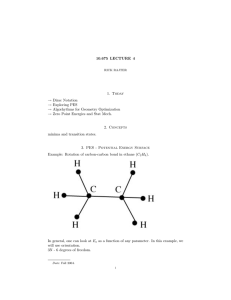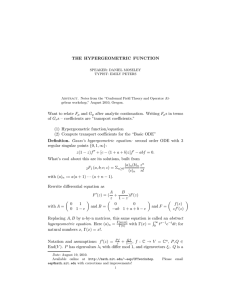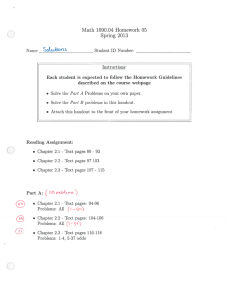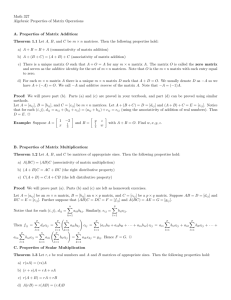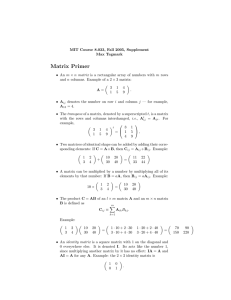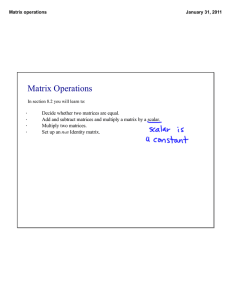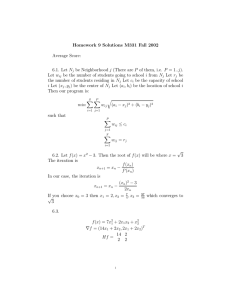Enabling Agents to Perform Prioritized Multi-Criteria Aggregation Ronald R. Yager
advertisement
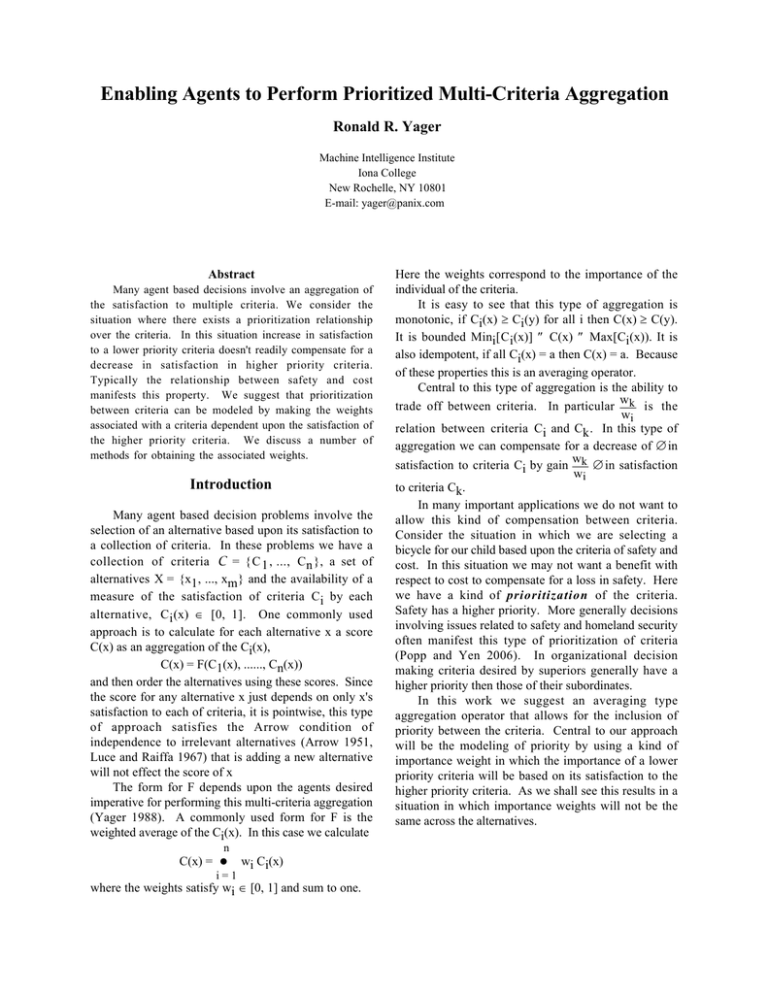
Enabling Agents to Perform Prioritized Multi-Criteria Aggregation
Ronald R. Yager
Machine Intelligence Institute
Iona College
New Rochelle, NY 10801
E-mail: yager@panix.com
Abstract
Many agent based decisions involve an aggregation of
the satisfaction to multiple criteria. We consider the
situation where there exists a prioritization relationship
over the criteria. In this situation increase in satisfaction
to a lower priority criteria doesn't readily compensate for a
decrease in satisfaction in higher priority criteria.
Typically the relationship between safety and cost
manifests this property. We suggest that prioritization
between criteria can be modeled by making the weights
associated with a criteria dependent upon the satisfaction of
the higher priority criteria. We discuss a number of
methods for obtaining the associated weights.
Introduction
Many agent based decision problems involve the
selection of an alternative based upon its satisfaction to
a collection of criteria. In these problems we have a
collection of criteria C = {C 1 , ..., Cn }, a set of
alternatives X = {x1, ..., xm } and the availability of a
measure of the satisfaction of criteria Ci by each
alternative, C i (x) ∈ [0, 1]. One commonly used
approach is to calculate for each alternative x a score
C(x) as an aggregation of the Ci(x),
C(x) = F(C1(x), ......, Cn(x))
and then order the alternatives using these scores. Since
the score for any alternative x just depends on only x's
satisfaction to each of criteria, it is pointwise, this type
of approach satisfies the Arrow condition of
independence to irrelevant alternatives (Arrow 1951,
Luce and Raiffa 1967) that is adding a new alternative
will not effect the score of x
The form for F depends upon the agents desired
imperative for performing this multi-criteria aggregation
(Yager 1988). A commonly used form for F is the
weighted average of the Ci(x). In this case we calculate
n
C(x) =
∑
i=1
wi Ci(x)
where the weights satisfy wi ∈ [0, 1] and sum to one.
Here the weights correspond to the importance of the
individual of the criteria.
It is easy to see that this type of aggregation is
monotonic, if Ci(x) ≥ Ci(y) for all i then C(x) ≥ C(y).
It is bounded Mini[C i(x)] ≤ C(x) ≤ Max[Ci(x)). It is
also idempotent, if all Ci(x) = a then C(x) = a. Because
of these properties this is an averaging operator.
Central to this type of aggregation is the ability to
trade off between criteria. In particular wk is the
wi
relation between criteria Ci and Ck . In this type of
aggregation we can compensate for a decrease of ∆ in
satisfaction to criteria Ci by gain wk ∆ in satisfaction
wi
to criteria Ck.
In many important applications we do not want to
allow this kind of compensation between criteria.
Consider the situation in which we are selecting a
bicycle for our child based upon the criteria of safety and
cost. In this situation we may not want a benefit with
respect to cost to compensate for a loss in safety. Here
we have a kind of prioritization of the criteria.
Safety has a higher priority. More generally decisions
involving issues related to safety and homeland security
often manifest this type of prioritization of criteria
(Popp and Yen 2006). In organizational decision
making criteria desired by superiors generally have a
higher priority then those of their subordinates.
In this work we suggest an averaging type
aggregation operator that allows for the inclusion of
priority between the criteria. Central to our approach
will be the modeling of priority by using a kind of
importance weight in which the importance of a lower
priority criteria will be based on its satisfaction to the
higher priority criteria. As we shall see this results in a
situation in which importance weights will not be the
same across the alternatives.
PRI-AVE: A Prioritized Averaging
Operator
In the following we assume that we have a
collection of criteria partitioned into q distinct
categories, H1 , H2 , ..., Hq such that Hi = {Ci1 , Ci2 ,
..., Cin ). Here Cij are the criteria in category Hi. We
i
assume a prioritization between these categories
H1 > H2, ... > Hq.
The criteria in class Hi have a higher priority than those
in Hk if i < k. The total collection of criteria is C =
q
∪
q
Hi. We assume n =
∑
i=1
i=1
n i the total number of
criteria.
We assume that for any alternative x ∈ X we have
a value Cij (x) ∈ [0, 1] indicating its satisfaction to
criteria Cij.
In the following we introduce an aggregation
operator which we refer to as the Prioritized Averaging
(PRI-AVE) aggregation operator which allows us to
calculate C(x) for any alternative.
The form of our aggregation operator is
C(x) = ∑ij wij(x) Cij(x)
Here the weights, which depend on x, will be used to
reflect the priority relationship. In order to obtain the
weights for a given alternative x we proceed as follows.
For each priority category Hi we calculate
Si = Minj[Cij(x)]
Here Si is the value of the least satisfied criteria in
category Hi under alternative x. Using this we will
associate with each criteria Cij a value uij called its preweight. For those criteria in category H1 we have u1j =
1. For those criteria in category H2 we have u2j = S1.
For those criteria in category H2 we have u3j = S1S2.
For those criteria in category H4 we have u4j =
S1S2S3. More generally uij is the product of the least
satisfied criteria in all categories with higher priority
than Hi.
We can more succinctly and more generally express
uij = Ti where
i
Ti =
∏
k=1
Sk-1
with the understanding that S0 = 1 by default. We note
that we can also express Ti as
Ti = Si-1 Ti-1
This equation along with the fact that T1 = S0 = 1
gives a recursive definition at Ti.
We now see that for all Cij ∈ Hi we have uij = Ti.
Using this we obtain for each Cij a weight wij with
respect to alternative x such that
u ij
w ij =
q
ni
∑ ∑
u ij
i=1j=1
More precisely we should use the notation wij (x)
however for simplicity we use wij.
Ti
Since u ij = Ti .this simplifies to w ij =
.
q
∑ n iT i
q
Furthermore if we denote T =
∑
i=1
niT i this further
i=1
T
simplifies to wij = i . It is easily seen that the wij ∈
T
[0, 1] and sum to one..
Using these weights we then get the aggregated
score for alternative x under this prioritization of criteria
as
C(x) = ∑ij wij Cij(x) =
1 ∑ T C (x)
T ij i ij
Before studying the properties of this aggregation
technique we look at an example
E x a m p l e : Consider the following prioritized
collection of criteria:
H1 = {C11, C12}, H2 = {C21}
H3 = {C31, C32, C33}, H4 = {C41, C42}
Assume for alternative x we have:
C11(x) = 0.7, C12(x) = 1, C21(x) = 0.9, C31(x) = 0.8,
C23(x) = 1, C33(x) = 0.2, C41(x) = 1, C42(x) = 0.9
We first calculate
S1 = Min[C11(x), C12(x)] = 0.7
S2 = Min[C21(x)] = -.9
S3 = Min[C31(x), C32(x), C33(x)] = -.2
S4 = Min[C41(x), C42] = 0.9
Using this we get
T1 = 1
T2 = S1T1 = 0.7
T3 = S2T2 = (0.9) (0.7) = 0.63
T4 = S3T3 = (0.2)(0.63) = 0.12
From this we obtain
u11= u12 = T1 = 1
u21 =T2 = 0.7
u31 = u32 = u33 = T3 = 0.63
u41 = U42 = T4 = 0.12
q
We obtain
T = ∑ u ij =
i,j
Let us denote C(x) = M where M = ∑ T i ai and
T
i=1
4
∑
n iT i
q
i=1
T = 2T1 + T2 + 3T3 + 2T4 = 4.83
From this we get
w = w12 = T1 = 0.20
11
T
w21 = T2 = 0.145
T
w31 = w32 = w33 = T3 = 0.13
T
T
4
w41 = w42 =
0.025
T
We now calculate
C(x) = ∑ij wij Cij(x) = 0.79
Properties of the PRI-AVE Operator
T =
∑
i=1
T i . For monotonicity to hold we have to
show that ∂C(x) ≥ 0 for any j. This requires that
∂aj
∂M
∂T
T
-M
∂aj
∂aj
≥ 0. Hence we must show that the
2
(T)
numerator is non–negative, T ∂M - M ∂T ≥ 0.
∂aj
∂aj
∂T
i
Before preceding we note that
= 0 for i ≤ j and
∂aj
q
∂Ti = Ti for i > j. We also note that M =
∑ T i ai =
∂aj aj
i=1
q
We now investigate the properties of this
aggregation method. In the following for simplicity let
us denote aij = Cij (x). Using this we have C(x) =
∑ ij w ij aij . First we see that this method of
aggregation is idempotent and bounded by the
maximum and minimum of the arguments. First
consider the boundedness. Assume a = Minij[aij] and
b = Maxij[aj] then since ∑ij wij = 1 we have
C(x) = ∑ij wij aij.≥ ∑ij wij a ≥ a
and
∑ij wij aij. ≤ ∑ij wij b ≤ b.
Hence Minij[aij] ≤ C(x) ≤ Maxij[aj] .
Consider now the case where all the aij are the
same, aij = d. In this case since ∑ ij wij = 1 we get
C(x) = ∑ ij wij d = d and hence the operation is
idempotent.
We now consider the issue of monotonicity. For
simplicity we shall look at the situation in which there
is only one criteria at each priority level. Here we
denote the criteria Cj, j = 1 to q. We shall denote the
satisfaction of each criteria to x as aj = Cj(x). We note
that in this case with one criteria at each level, Si = ai.
Here then T1 = 1, T2 = a1 and more generally Ti =
i
∏
k=1
∑
i=1
Ti+1 since Ti ai = Ti+1. However we shall find it
q+1
more useful to express M =
We shall denote A = ∂M
∂aj
q
∑
C(x) = i = 1
Ti ai
T
T i.
q+1
= 1 ∑ T i.
aj i = j+1
We
q
shall also let B = ∂T hence since T = ∑ Ti we have
∂aj
i=1
q
B = ∂T = 1 ∑ T i. From this we observe that A ≥
∂aj aj i = j+1
B. In the following we shall find it convenient to
j
denote E =
∑
i=2
T i.
Consider now the term T ∂M - M ∂T = AT - BM.
∂aj
∂aj
We now observe that
q
T=
∑
j
i=1
Ti =
∑
i=1
Ti + aj B.
Since T 1 = 1 then T = 1 + E + aj B. We further
observe that
q+1
M=
∑
i=2
Sk-1. Using this we have
∑
i=2
Ti. = E + aj A.
Using the relations we see that
AT - BM = A( 1 + E + aj B) - B( E + aj A)
AT - BM = A + EA + aj BA - BE - aj BA
AT - BM = A + E(A - B)
Since A ≥ B it follows that AT - BM ≥ 0
The proof of monotonicity in the case where we
can have multiple criteria at each level, although
slightly more complicated, follows in the same spirit
We now look at some further properties of the
proposed aggregation method. We recall Hi = {Cij | j =
1 to ni} where the criteria in category Hi have priority
over those in Hk if ii i < k. Again letting aij = Cij(x)
Cij(x) = aij. Using this notation then we defined
So = 0
Si = Mini[aij] for i = 1 to q
i
Ti =
T=
i
we have Si = Minj[aij] and So = 1 and Ti =
q
∏
k=1
Sk-1.
Here with uij = Ti and T = ∑ n i Ti we have wij =
i=1
uij Ti
= we have
T
T
q
q
ni
ni
C(x) = ∑ ( ∑ wij aij) = 1 ∑ Ti( ∑ aij)
Ti = 1
i=1 j=1
j=1
ni
q
∑ aij we have C(x) = T1 ∑ Ti Ai.
j=1
i=1
We see that the weight associated with the elements
Letting Ai =
i
in the ith category are Ti where Ti = ∏ S k-1 . Thus
T
k=1
the criteria in Hi contribute proportion to the product of
the satisfaction of the higher order criteria. Thus poor
satisfaction to any higher criteria reduces the ability for
compensation by lower priority criteria.
We also observe that if there exists some category
Hr such that Crj(x) = 0 for some criteria in Hr.then Sr =
r
0 and Ti = 0 for i > r and hence C(x) = 1 ∑ T i Ai.
Ti = 1
Note: While in the preceding we assumed Cij(x) ∈
[0, 1] this is not necessarily required. If we let Fij R
→ [0, 1] be some function from the real numbers into
the unit intervals such that Fij(Cij(x)) is some measure
of how satisfied we are with a score Cij(x) for criteria
Cij then we allow the values of Cij(x) be any number if
we calculate
Si = Minj[Fij(Cij(x) ]
Here we just transfer the Cij(x) into numbers in the unit
interval for calculating Si.
Alternative Determination of Weights
In the preceding we introduced a prioritized multicriteria aggregation method in which our criteria are
partitioned into q categories, Hi = { Cij/j = 1 to ni }
where category Hi had priority over Hk if i < k. Here a
given alternative x its satisfaction to criteria Cij is
∏
k=1
q
∑
Sk-1 for 1 = to q
n iT i
i=1
With wij = Ti we obtained as our aggregated value
T
q
q
ni
ni
1
w
a
=
C(x) = ∑ ∑ ij ij
∑ ∑ Tiaij
T i=1 j=1
i=1 j=1
ni
Letting Ai =
∑
aij we can express this as
j=1
n
C(x) = 1 ∑ TiAi .
T i=1
In the preceding we assumed that the satisfaction to
the priority class Hi = {Ci1, ..., Cin } under alternative
i
x was determined by the least satisfied criteria in Hi,
S i = Min j [C ij (x) ]. Here we shall suggest some
alternative methods for calculating Si.
One method we shall consider will be based on the
OWA aggregation operator (Yager 1988, Yager and
Kacprzyk 1997). Here we associate with each priority
class Hi a vector V i of dimension ni called the OWA
weighting vector. The components Vik of Vi are such
that Vik ∈ [0, 1] and
ni
∑
k=1
Vik = 1. Additionally we let
ind i (k) be an index of function so that bik (x) =
C ind (k)(x) is the kth largest of Cij(x). Using this we
i
now calculate
ni
Si =
∑
k=1
Vik bik(x)
We see that if Vin = 1 and Vik = 0 for k ≠ ni then we
i
get Si = Minj [ C ij (x)], the original method. An
important special case is where Vik = 1/ni for all k. In
ni
this case Si = 1 ∑ Cij(x). Here we take as Si the
ni j = 1
average of the satisfactions of the criteria in category
H i. Another special case is when Vil = 1 and Vik = 0
for k ≠ 1. In this case Si = Maxj[C ij(x) ]. Here we
take Si as the score of the most satisfied criteria in
category Hi. Many other weight vectors are possible
for example if Viq = 1 for some q Si simply becomes
the qth largest of the Cij(x).
In this framework we can associate with each
weighing vector V i a measure called its attitudinal
character denoted, A-C(V i) (Yager 2002). We define
this as
ni
1 ∑ V (n - k)
ik i
ni - 1 k = 1
It can easily be shown that for the case where Vin = 1
i
we get A-C(V i ) = 0. For the case where
A–C(V i ) = 1 then A-C(V i) = 0.5 and for the case
ni - 1
where Vi1 = 1 we have A-C(Vi) = 1.
If we denote A-C(Vc) = αi then we see in figure #1
the relationship between the value of α i and the form
for the calculation of Si. Here then α can be seen as a
ι
measure of the t o l e r a n c e in determining the
satisfaction of the category. While it is not necessary,
it would be seen that the default situation is to assume
αι is the same for all Hi.
α
i
1
0
0.5
A-C(Vi) =
S
S
i = Ave j [C ij (x)]
[C (x)]
i = Min j ij
S
[C
i = Max j ij (x)]
Figure #1. Relationship between α i and the
form of Si.
Many of the techniques available for calculating the
OWA weights (Xu 2005) can be tailored for this
particular application. A particularly interesting
possibility is to use a variation of the method originally
suggested by O'Hagan (O'Hagan 1990, Fuller and
Majlender 2003). In this case we would supply a
desired level of tolerance α i and solve the following
mathematical programming problem for the Vik
ni
Min
∑
(ViK)2
K=1
Such that:
ni
1 ∑ V (n - k) = α
ik i
i
ni - 1 k = 1
ni
∑
k=1
V ik = 1
V ik ≥ 0
We provide an of the preceding variation using the
earlier example
Example:H1 = {C11, C12}, H2 = {C21}
H3 = {C31, C32, C33}. H4 = {C41, C42}
For alternative x we have
C11(x) = 0.7, C12(x) = 1, C21(x) = 0.9,
C31(x) =0 .8, C32(x) = 1, C33(x) = 0.2
C41(x) = 1, C42(x) = 0.9
Consider the case where Si = Maxj[Cij(x)]. Here then
S1 = 1, S2 = 0.9, S3 = 1, S4 = 1
From this we get :
T1 = 1
T 2 = S1 T1 = 1
T3 = S2 T2 = 0.9
T4 = S3 T3 = 0.9
In this case
4
T=
∑
n iT i
i=1
T = (2)(1) + (1)(1) + (3)(0.9) + (2)(0.9) = 7.5
ni
4
With C(x) = 1 ∑ A i Ti where Ai = ∑ C ij(x) we
Ti = 1
j=1
have
C(x) = 1 ((1)(1.7) + (1)(.9) + (0.9)(2) + (0.9)(1.9)
7.5
C(x) = 1 (6.11) = 0.815
7.5
Another approach for calculating the Si involves
associating with each criteria in Hi an additional local
weight. In this case our form for Hi is
Hi= {(Cij, gij) | j = 1 to ni }
where the gij indicates the importance of Cij in
calculating Si. Here we assume that gij ∈ [0, 1] and
ni
∑
g ij = 1. Using these weights we can calculate
j=1
ni
Si =
∑
gijCij(x) .
j=1
An interesting special case of this is where some
criteria Cij has gij = 0. In this case the criteria plays no
role in the determination of Si but still is able to
contribute to the overall calculation of C(x).
Another available method for calculating the Si
involves the idea of combining these local weights with
a tolerance level. Here we assume for each Hi we have
Hi = {(Cij, gij), j = 1 to ni}
gij ∈ [0, 1] and
ni
∑
j=1
g ij = 1, where again g is the
ij
indication at the importance of Cij in calculating Si. In
addition we assume a tolerance level α i ∈ [0, 1]
associated with Hi . Using one of the methods for
generating OWA weights we can obtain a set of OWA
weights, Vik, for k = 1 to ni. Let ndi be an index such
ndi(k) is the index of the k largest of the Cij(x). That is
b ik = Ci,nd (k)(x) is the value of the k most satisfied
i
criteria in H i . With di k = gi,nd
being the
i(k)
importance weight associated with this kth most
satisfied criteria on H i we calculate hi k =
dik ⋅ Vik
Using this we calculate S i =
n
i
∑
dik ⋅ Vik
∑
h ik bik. In the special case when Vik = 1 for all
n
k=1
ni
K=1
i
k this reduces to the weighted average introduced earlier,
ni
Si =
∑
g ij Cij(x).
j=1
Conclusion
We considered criteria aggregation problems where
there is a prioritization relationship over the criteria.
We suggested that prioritization between criteria can be
modeled by making the weights associated with a
criteria dependent upon the satisfaction of the higher
priority criteria. This resulted in a situation in which
the weights associated with the criteria depended upon
the alternative being evaluated. We introduced a number
methods for obtaining the weights.
References
Arrow, K. J. 1951. Social Choice and Individual
Values, John Wiley & Sons: New York.
Fuller, R. and Majlender, P. 2003. "On obtaining
minimal variability OWA weights," Fuzzy Sets and
Systems 136, 203-215.
Luce, R. D. and Raiffa, H. 1967. Games and
Decisions: Introduction and Critical Survey, John Wiley
& Sons: New York.
O'Hagan, M. 1990. "A fuzzy neuron based upon
maximum entropy-ordered weighted averaging," in
Uncertainty in Knowledge Bases, edited by BouchonMeunier, B., Yager, R. R. and Zadeh, L. A., SpringerVerlag: Berlin, 598-609.
Popp, R. L. and Yen, J. 2006. Emergent Information
Technologies and Enabling Policies for CounterTerrorism, John Wiley & sons: Hoboken, NJ.
Xu, Z. 2005. "An overview of methods for determining
OWA weights," International Journal of Intelligent
Systems 20, 843-865.
Yager, R. R. 1988. "On ordered weighted averaging
aggregation operators in multi-criteria decision
making," IEEE Transactions on Systems, Man and
Cybernetics 18, 183-190.
Yager, R. R. 2002. "On the cardinality index and
attitudinal character of fuzzy measures," International
Journal of General Systems 31, 303-329.
Yager, R. R. and Kacprzyk, J. 1997. The Ordered
Weighted Averaging Operators: Theory and
Applications, Kluwer: Norwell, MA, 1997.
